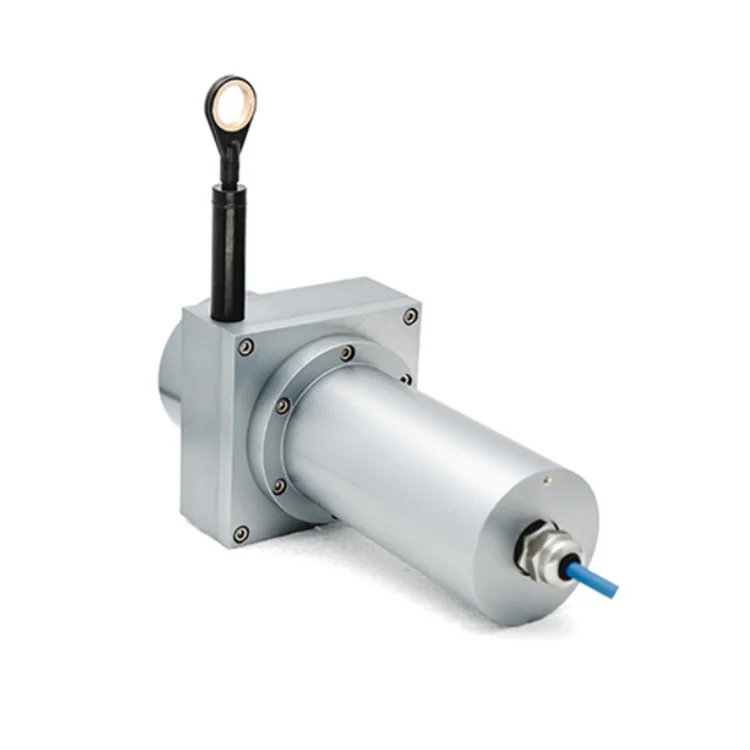- This topic is empty.
-
AuthorPosts
-
2025-07-16 at 3:31 pm #3978
In the ever-evolving landscape of industrial automation, precision and real-time feedback are critical to ensuring operational efficiency, repeatability, and system reliability. One component that plays a vital role in achieving these outcomes is the precision draw wire encoder. Also known as cable extension encoders or string potentiometers, these devices are designed to convert linear motion into accurate electrical signals, which are then interpreted by control systems for motion analysis or position tracking. In this blog post, as a high precision draw wire sensor manufacturing factory, ENX Enxiao will share the application of precision draw wire encoder in industrial automation equipment.
Introduction to Precision Draw Wire Encoder for sale
A precision draw wire encoder consists of a flexible cable wound on a spring-loaded spool, which is attached to a rotary encoder. When the cable is extended or retracted, the spool rotates, and the encoder converts this rotary motion into electrical signals. These signals correspond to the linear displacement of the object being measured.
There are typically two major categories of draw wire encoders:
* Incremental Encoders: Output pulse signals corresponding to motion increments.
* Absolute Encoders: Output specific position data, even after power loss or system reset.
Their compact design, high precision, and durability make them ideal for applications that require long-range and accurate displacement measurement.

Application of Precision Draw Wire Encoder in Industrial Automation
1. Robotic Arm Positioning and Calibration
In robotic systems used for welding, assembly, or packaging, knowing the precise position of moving components is crucial. Draw wire encoders can be installed along the axes of robotic arms to provide continuous feedback on arm extension or joint movement. Their high resolution ensures accurate repeatability, critical in tasks like laser cutting or micro-assembly.
2. Elevator and Lift System Monitoring
Precision draw wire encoders are widely used to monitor the vertical position of elevator cars, automated vertical storage systems, or scissor lifts. They offer a non-contact solution that eliminates mechanical wear, providing reliable measurements even in environments with vibration and dust.
3. Automated Storage and Retrieval Systems (ASRS)
In logistics and warehousing, ASRS systems rely heavily on accurate linear positioning for storage and retrieval operations. Draw wire encoders ensure that cranes and shuttles operate with millimeter-level accuracy, reducing errors in item placement and retrieval, thus boosting throughput.
4. Injection Molding and Press Machines
During mold setup and operation, it is essential to know the position of the die or mold. Draw wire encoders offer precise stroke measurement in molding presses or metal stamping machinery, enabling better cycle control and improving mold life.
5. Construction and Mining Equipment
Industrial automation extends to rugged environments, such as construction and mining. Here, precision draw wire encoders are used in crane booms, drilling rigs, and excavators to measure the extension of hydraulic arms or booms. Their robust design and environmental protection ensure uninterrupted operation.
Advantages Over Traditional Measurement Devices
Compared to linear potentiometers, laser sensors, or proximity sensors, draw wire encoders offer several distinct advantages:
* Extended Measurement Range: They can measure distances ranging from a few millimeters up to several meters.
* High Accuracy and Resolution: Capable of micrometer-level precision, essential for high-precision applications.
* Durability: With protective housing (IP65/IP67), many models withstand harsh environments including exposure to dust, water, and vibration.
* Simple Installation: They can be mounted in tight spaces, with flexible routing of the cable.
* Cost Efficiency: Compared to high-end laser measurement systems, draw wire encoders offer an economical solution without compromising accuracy.
Integration with Control Systems
One of the defining features of modern draw wire encoders is their compatibility with industrial communication protocols such as:
* Analog (0–10V, 4–20mA)
* Digital (Incremental, SSI, CANopen, PROFIBUS, EtherCAT)
This makes them easy to integrate into programmable logic controllers (PLCs), human-machine interfaces (HMIs), and industrial PCs. Real-time data acquisition enables predictive maintenance, remote monitoring, and adaptive control algorithms, making the manufacturing process smarter and more efficient.
Design Considerations for System Engineers
When selecting a draw wire encoder for industrial automation, engineers must consider:
* Measurement Range: Ensure that the cable length meets or exceeds the maximum displacement expected.
* Resolution and Accuracy Requirements: Match the device’s performance specifications with application needs.
* Output Signal Type: Choose based on the existing control system input compatibility.
* Environmental Conditions: Select encoders with appropriate IP rating, temperature range, and housing material for the installation environment.
* Mounting Flexibility: Account for installation space and desired cable direction (vertical, horizontal, or angled).
These considerations directly influence the reliability and longevity of the automation system.
Real-World Case Study: Automated Gantry Systems
In an industrial packaging plant, an automated gantry system was tasked with transporting goods across multiple stations. Precision draw wire encoders were installed on each axis of the gantry. By providing continuous position feedback to the central PLC, the system was able to operate at optimal speed without overshooting or stalling. As a result, the plant reported a 20% increase in throughput and a 15% reduction in maintenance downtime due to early fault detection via position trend analysis.
Conclusion
Precision draw wire encoders are indispensable tools in the realm of industrial automation. Their ability to provide accurate, reliable, and real-time linear position feedback makes them ideal for a wide range of applications—from robotics and manufacturing to logistics and construction. As automation systems grow more complex and interconnected, these encoders will continue to play a pivotal role in ensuring precision, efficiency, and adaptability in industrial operations.
http://www.enxsensors.com
ENX Enxiao -
AuthorPosts
- You must be logged in to reply to this topic.
